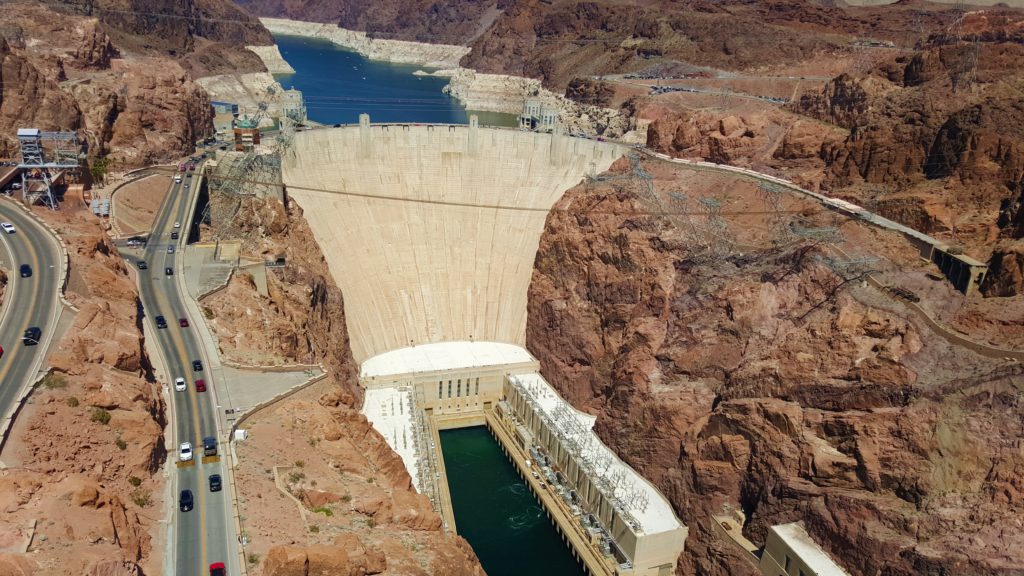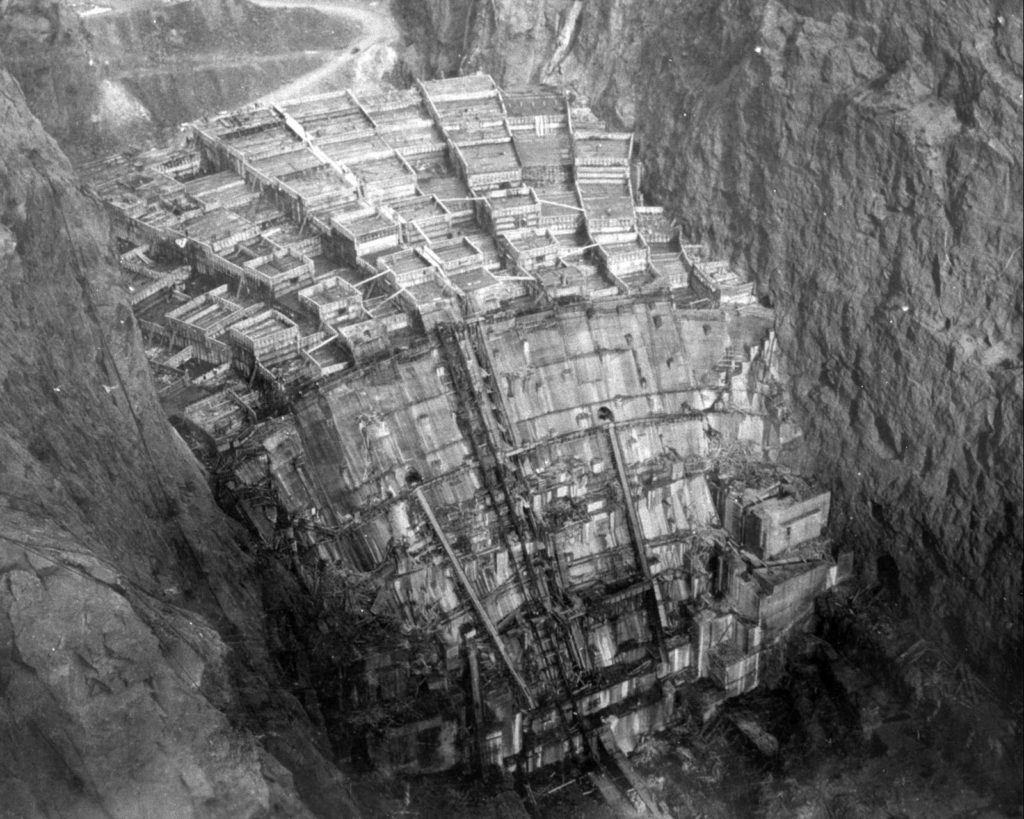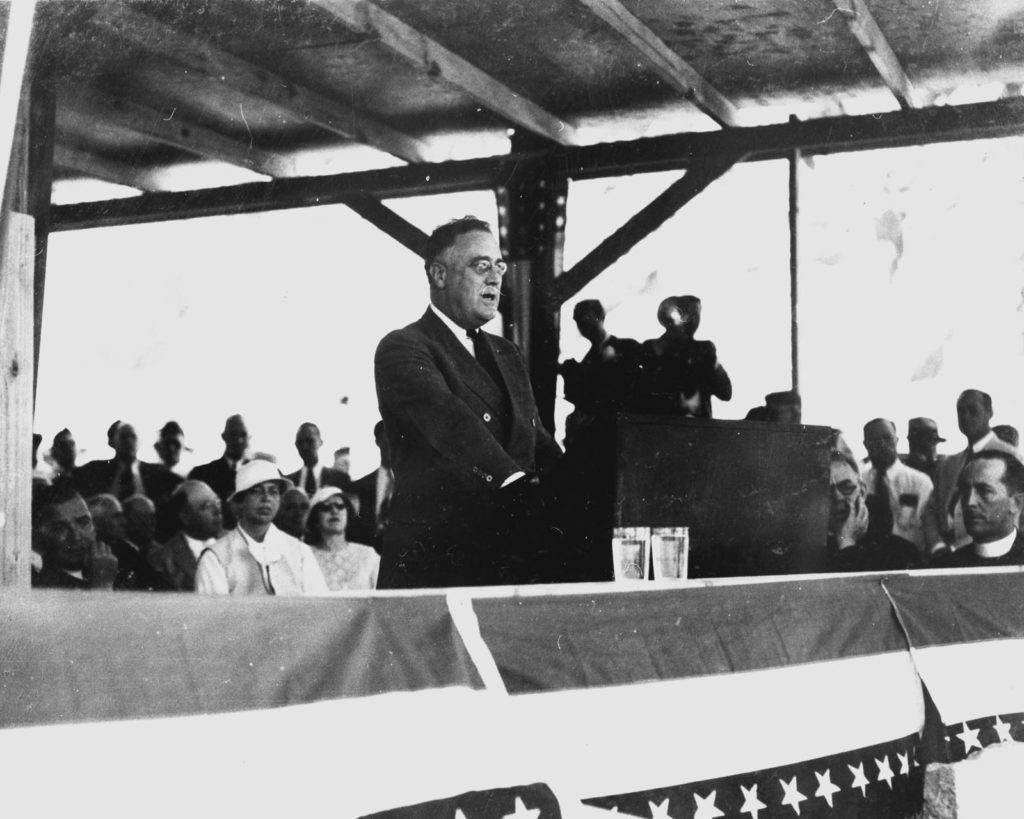Turns out that September 30 is a pretty dam important day! Two major dam-related events occurred on this date, both relating to the availability of water and water-based energy.
The first event, on September 30, 1882, didn’t make much of a splash then and is remembered even less today. Dams had always been used for power, by building up a head of water behind the dam and directing water that fell over the top of the dam into a water wheel. The water turned the wheel, which then turned grinding stones and other devices. As time passed, these water mills got more complicated, with the wheel’s shaft attached to long axles that could power many tools, like saws and conveyor belts.
But on this date in 1882, something special happened. In Appleton, Wisconsin, the owner of a paper mill, H. J. Rogers, attached a dynamo (that’s a generator for electricity) to his water wheel and began producing electricity. His small dam on the Fox River generated enough electricity to power his paper mill and the lights in his house. Within a few years, similar electric generators were in use on small dams across the United States and soon throughout the world. Most of these were short dams, only a few feet high, with a low capacity to generate electricity.

As the inventions of the industrial revolution began to allow bigger machines and structures to be built, dams got in on the action. Dams got taller and longer; they were built with concrete and steel rather than dirt and wood; they contained large turbines that could generate massive amounts of electricity. The U.S. government got into this business in a big way in 1902, when the Reclamation Act created the Bureau of Reclamation and authorized work across the American West to create dams, canals and other structures for irrigation, flood control, and hydro-electricity.
The U.S. built many large dams during the first half of the 20th Century, but the crowning masterpiece was Hoover Dam, dedicated by President Franklin Roosevelt on—you guessed it—September 30, in the year 1935. Hoover Dam was then and is still now considered a monumentt to the ingenuity, hard work and undaunted optimism of the American spirit.
Hoover Dam impounds the Colorado River along the Nevada-Arizona border, a few miles southeast of Las Vegas. Enterprising businessmen had tried to tame the Colorado River many times, primarily to supply irrigation water to southern California’s sprawling farmlands. Their attempts to build earthen dams, levees and canals always ended in disaster as the powerful and unpredictable Colorado River triumphed over their amateurish engineering. Taming the Colorado River would require the full force of the U.S. government and much bigger thinking than had been used before.

So, in 1928, Congress authorized funding for the Boulder Canyon Project, the largest dam ever built up to that time. A site was found in Black Canyon on the Colorado, where nearly vertical rock walls rose over 800 feet from the river. Construction began in 1931 on the gargantuan project. First, massive tunnels were blasted into the canyon walls so the Colorado River could be re-directed around the dam site during construction. The four tunnels were 56 feet in diameter, running in total more than three miles through the hard rock. The rock from inside the tunnels was then used to make a temporary dam (called a coffer dam) on the river high enough that all the water could be diverted through the tunnels, leaving a dry river bottom.
Then workers at the dam site began to remove loose materials from the shear canyon walls. Suspended from ropes, the workers—many of whom were Native Americans—picked, drilled and blasted their way down the canyon walls. Only then, two years into the project, could the actual dam construction begin. Massive amounts of concrete were transported in huge buckets from the cliff tops to the river bottom. Slowly—very slowly, so the concrete could cool without cracking—the dam took shape, rising to the huge arched shape we so proudly recognize today as Hoover Dam.

The story of building the dam could fill a book (actually, it has filled many books), but let’s end with a few facts about the project. About 21,000 workers labored on the dam, and nearly 100 of them lost their lives in the process. The amount of concrete used could have paved a road from San Francisco to New York City. The dam, which was the largest in the world when it was completed in the summer of 1935, is 726 feet high and 1,244 feet long. It provides irrigation water for about 2 million acres of California’s agricultural lands. The dam runs 17 turbines that provide electricity for 1.3 million homes. It impounds Lake Mead, one of the world’s largest reservoirs.
Ten thousand people crowded around the dam on September 30, 1935, in 102-degree temperatures, to listen as President Roosevelt dedicated the dam.
“This morning,” he said, “I came, I saw, and I was conquered, as everyone would be who sees for the first time this great feat of mankind. …We know that, as an unregulated river, the Colorado added little of value to the region this dam serves. When in flood the river was a threatening torrent. In the dry months of the year it shrank to a trickling stream….That is why I have the right once more to congratulate you who have built Boulder Dam and on behalf of the Nation to say to you, ‘Well done.’”
Opinions about dams in the U.S. have changed a great deal since then, but the triumph of human capabilities and the positive values that come from the effective management of water can hardly be questioned. Let’s just hope that those capabilities become even more effective when we acknowledge that rivers, even if not tamed by humans, have enormous value to the regions through which they flow.
References:
Bureau of Reclamation. Hoover Dam. Available at: https://www.usbr.gov/lc/hooverdam/index.html. Accessed July 16, 2019.
Encyclopedia Britannica. Hoover Dam. Available at: https://www.britannica.com/topic/Hoover-Dam. Accessed July 16, 2019.
History.com. Hoover Dam. Available at: https://www.history.com/topics/great-depression/hoover-dam. Accessed July 16, 2019.
National Park Service. Reading 3: Excerpts from President Franklin D. Roosevelt’s Speech at the Dedication of Boulder Dam, Sept. 30, 1935. Available at: https://www.nps.gov/nr/twhp/wwwlps/lessons/140HooverDam/140facts3.htm. Accessed July 16, 2019.
National Park Service. 5. The Origins of Hydroelectric Power. Available at: https://www.nps.gov/articles/5-the-origins-of-hydroelectric-power.htm. Accessed July 16, 2019.
